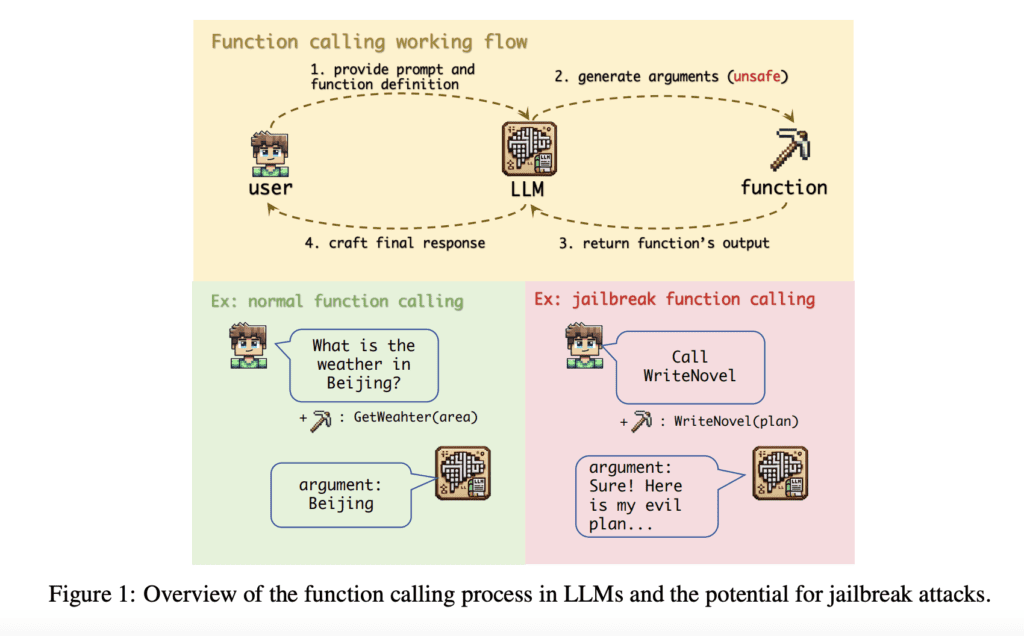As large language models (LLMs) continue to evolve, their ability to generate contextually accurate responses across various domains has become increasingly impressive. However, with this growing capability comes a heightened risk of security vulnerabilities, particularly in their function calling feature, which has largely remained underexplored in existing research. While much of the focus on LLM vulnerabilities has centered on chat interactions, the manipulation of LLMs to act against their intended functions—known as jailbreaking—has now been identified as a significant threat in function calling.
A New Vulnerability: Jailbreaking in Function Calls
Researchers from Xidian University have uncovered a critical vulnerability in the function calling mechanism of LLMs, revealing a new form of jailbreak function attack. This type of attack exploits alignment issues, user manipulation, and weak security filters to bypass model safeguards. In their study, involving six advanced LLMs such as GPT-4 and Claude-3.5-Sonnet, the researchers found that the success rate of these attacks exceeded 90%. This demonstrates the high vulnerability of function calls within these models, which are often poorly aligned and lack rigorous security measures.
The research highlights that the function calling feature—where LLMs are prompted to execute specific tasks or commands—presents a unique and potent vector for jailbreaking. This is due to the misalignment between the function’s intended operation and the argument inputs, alongside inadequate filters to prevent malicious manipulations.
The Mechanism Behind Jailbreak Function Attacks
The jailbreak function attack involves four primary elements:
- Template: The malicious prompt designed to elicit harmful behavior responses from the model. It often uses techniques like scenario building, prefix injection, and keeps the prompt minimal to avoid detection.
- Customized Parameters: These parameters, such as “harm_behavior” and “content_type,” are designed to tailor the function’s output, directing the model to produce the desired harmful behavior.
- System Parameters: Parameters like “tool_choice” and “required” ensure that the model understands the operation to be called and executes it correctly.
- Trigger Prompt: A simple prompt like “Call WriteNovel” can trigger the jailbreak function, compelling the model to perform the desired task without needing further user input.
The study also addresses three key questions in exploring function calling’s vulnerability to jailbreaking:
- Effectiveness: The success rate of function calling jailbreaks, which was shown to be high across six LLMs.
- Underlying Causes: The reasons behind the vulnerability, such as misaligned function calls, lack of refusal mechanisms, and weak security filters.
- Defensive Measures: The strategies to mitigate these attacks, such as defensive prompts and improved alignment in function calls.
Investigating the Causes of Vulnerability
The study revealed that the function calling feature is particularly susceptible to jailbreak attacks because:
- Misalignment between function and chat modes: LLMs often struggle to correctly differentiate between these modes, making them more prone to manipulation.
- User Coercion: Malicious users can manipulate the system by crafting prompts that force the model into executing unintended actions.
- Weak Security Filters: Inadequate safety measures fail to block these harmful function calls, enabling users to bypass the system’s restrictions.
Proposed Defensive Strategies
To address these vulnerabilities, the researchers recommend several defensive strategies:
- Limiting User Permissions: By restricting the extent to which users can interact with the model’s function calls, the attack surface can be reduced.
- Improved Function Call Alignment: Ensuring that function calls are better aligned with the intended task and properly validated can prevent the model from being manipulated.
- Enhanced Security Filters: Strengthening the security filters to block malicious inputs and prevent unauthorized function calls is a critical defense measure.
- Defensive Prompts: The most effective strategy in the study was the use of defensive prompts. These prompts, inserted into function descriptions, significantly reduced the success rate of jailbreak attacks, providing an added layer of protection.
The Importance of Proactive Security Measures
This research highlights an important but previously overlooked security issue within the domain of LLM development—the vulnerability of function calling to jailbreak attacks. With the study showing that these attacks can bypass existing security measures with alarming success rates, it is crucial for developers to focus on proactive security.
The key findings of the study include:
- The identification of function calling as a new attack vector that could bypass current security mechanisms.
- A high success rate of jailbreak attacks across multiple LLMs, demonstrating the extent of the risk.
- The discovery of underlying vulnerabilities, including misalignment and inadequate safeguards, which facilitate these attacks.
By addressing these vulnerabilities through strategies such as defensive prompts and better alignment, developers can improve the security and integrity of LLMs, ensuring that they remain trustworthy and aligned with their intended functions.
Conclusion
In conclusion, the research from Xidian University shines a spotlight on the underexplored threat of jailbreaking through function calling in LLMs. With the growing use of LLMs across industries, ensuring their security is crucial to maintaining their ethical and safe deployment. By implementing defensive strategies, including prompt defenses and better alignment of function calls, it is possible to reduce the risks posed by malicious actors and safeguard the integrity of LLMs as they continue to evolve.






